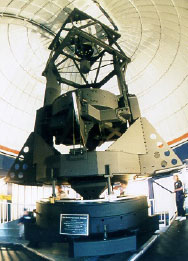Where We Started
Steve Kirsch identified only two ways that would make it impossible for life to continue on Earth. One way was through a nuclear war; the other would be through a large asteroid, also known as a Near Earth Object (NEO), hitting the Earth. Despite awareness of this distant - but distinct - possibility, there was only limited funding from governments and other philanthropists to identify and track NEOs. To begin to address this threat, the Foundation dedicated $100,000 a year in grants for detection efforts.
Milestones
As we developed our Medical and Science Programs in 2001, we recognized that funding only detection would be inadequate to address the dangers posed by asteroids. We therefore began to fund supplementary efforts such as NEO composition studies and public awareness building, which increased our allocation to more than $150,000 annually. We also sought, unsuccessfully, to engage other philanthropists in this admittedly unusual work.
By early 2003, it became clear that our limited grant funding was insufficient to identify and track all large NEOs in a reasonable timeframe. This prompted us to reevaluate the best use of our resources. After discussions with NEOs researchers about the entire field, we determined that our funds could be highly leveraged if NEOs research funding at the federal level increased. This resulted in a decision to transfer our NEOs-specific funding from grants to lobbying.
Our Current Efforts
In late 2003, the Foundation contracted with a Washington, DC, government relations firm to undertake a one-year campaign for augmented funding in the 2003-04 congressional budget cycle for NEOs detection and tracking research. We considered authorization and appropriations bills, found sponsors on Capitol Hill in both the Senate and the House for a significant appropriation, lobbied Members of Congress throughout the Spring, and gained other key support. Regardless of the final vote on this appropriation, we have substantially increased awareness of NEOs and have laid the groundwork for future lobbying activities.
|
|
What happens if a big asteroid hits Earth? Judging from realistic simulations involving a sledge hammer and a common laboratory frog, we can assume it will be pretty bad.”
• Dave Barry, Humorist |
|
 |

The 1.8 meter Spacewatch telescope which is used for NEOs identification and tracking.
|
|
